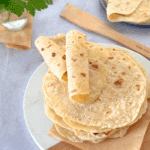Watch how to make the recipe
Ingredients
- 1 cup + 1 Tablespoon cottage cheese (250 g)
- 1¾ cups all-purpose flour or plain flour (220 g)
- ¼ teaspoon salt (optional)
Instructions
Mash out chunks in your cottage cheese with a fork first
- It doesn’t have to be completely smooth, just soft enough to mix easily into the flour.If your cottage cheese is very watery (curds floating in liquid or drippy), pour off a teaspoon or two of liquid before mashing.
Combine flour and mashed cottage cheese
- Add the mashed cottage cheese, flour, and salt (if using) to a large bowl. Stir until the mixture starts to come together. The dough may look dry or shaggy at first, this is normal.
- Knead the dough in the bowl for 3 to 4 minutes, until soft and smooth.
- At first, the flour might seem like it isn’t fully mixing in. Just keep gathering and pressing it together, the cottage cheese gradually absorbs the flour.
- After a few minutes, you’ll have a soft, smooth dough that’s easy to handle and doesn’t stick to your hands.
Divide dough, roll and cook
- Divide the dough into 10 to 12 equal pieces and roll each into a ball.
- Roll each ball into a circle about 7 to 8 inches (18 to 20 cm) wide and 2 to 3 mm thick (about ⅛ inch). (see notes)
- Lightly flour the surface if needed to prevent sticking.
- Heat a dry nonstick or cast iron skillet over medium heat.
- Cook each flatbread for 1 to 2 minutes per side, until golden spots appear and the flatbread is cooked through.
- Stack the cooked flatbreads on a plate and cover with a kitchen towel or paper towels to keep them soft while you finish the batch.
Storage
- Room temperature: Let cool completely. Store in an airtight container for up to 2 days.
- Refrigerator: Store in the fridge for up to 3 days. Reheat in a dry skillet or toaster oven.
- Freezer: Freeze cooked flatbreads in a stack with parchment between each. Reheat from frozen in a dry pan or oven, no need to thaw.
Recipe Notes
Any kind of cottage cheese works: full-fat, low-fat, or fat-free.
- If your cottage cheese is chunky, mash it with a fork before using.
- If it’s very watery (curds floating in liquid or drippy), pour off a teaspoon or two before mixing.
- Don’t use cream cheese, it’s too thick and dry for this dough.
Rolling the flatbreads: This dough doesn’t need to rest—just knead and roll.
But if it feels a little springy or hard to roll out, you can let it rest for 5 to 10 minutes, covered.
This gives the flour time to relax and makes rolling easier. Most of the time, it’s ready to roll right away.
But if it feels a little springy or hard to roll out, you can let it rest for 5 to 10 minutes, covered.
This gives the flour time to relax and makes rolling easier. Most of the time, it’s ready to roll right away.
Nutrition note: The values below were calculated using full-fat cottage cheese.
If you use low-fat or fat-free, the values will vary slightly.
If you use low-fat or fat-free, the values will vary slightly.
See the post above for extra tips and photos of the main steps.
Nutrition
Serving: 1flatbread | Calories: 100kcal | Carbohydrates: 17g | Protein: 5g | Fat: 1g | Saturated Fat: 0.4g | Polyunsaturated Fat: 0.1g | Monounsaturated Fat: 0.2g | Cholesterol: 4mg | Sodium: 125mg | Potassium: 45mg | Fiber: 1g | Sugar: 1g | Calcium: 21mg | Iron: 1mg
